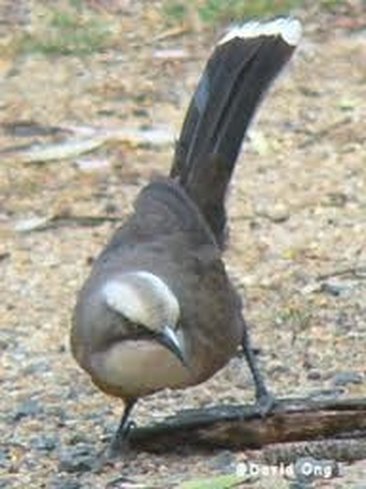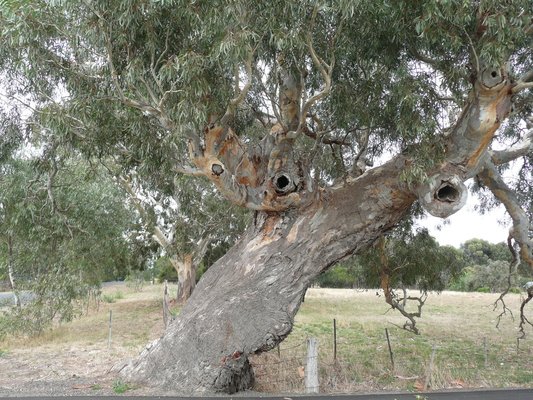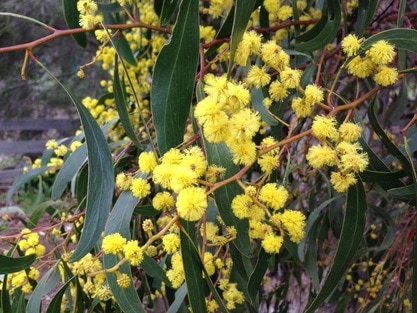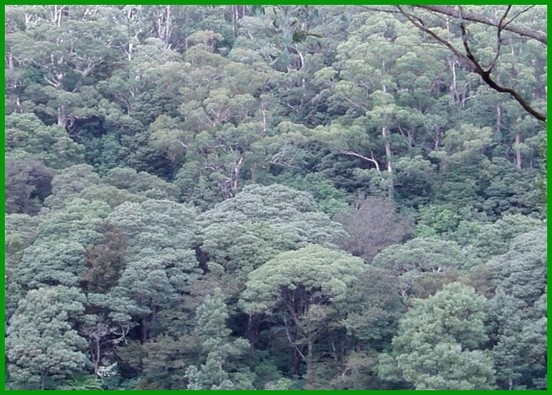Design to restore lost biodiversity
|
Design to restore lost biodiversity and bring back endangered wildlife
 The Grey-crowned Babbler has benefited from the planting for the Regent Honeyeater near Benalla, Victoria. Its numbers have recovered because small isolated flocks can now migrate along newly planted tree corridors
The Grey-crowned Babbler has benefited from the planting for the Regent Honeyeater near Benalla, Victoria. Its numbers have recovered because small isolated flocks can now migrate along newly planted tree corridors
Bringing back endangered wildlife to rural and urban Australia is one of the significant challenges of this decade. Australia's wildlife is the 'canary in the coal mine ' and an indication of the health of our living environment. We need to reverse the current trend of species extinctions to ensure clean air, clean water and a robust biodiversity for future generations.
Designing for biodiversity will help us meet this challenge by laying the foundations for a healthy, diverse and resilient environment.
Sustainable biorich landscapes mimic natural environments and function like natural environments. They provide fauna and flora with all the essential elements that they need for a sustainable ecology. Like natural environments they are diverse, they are wide enough to provide plentiful protected habitat for wildlife, their structural layers add safety and efficiency of foraging and their links to remnant vegetation and water enable plants and animals to interact and evolve. They provide habitat and food resources for a diversity of wildlife.
'Plant it and they will come' - native fauna will return if you provide them with what they need. Your garden or back paddock can become part of the solution to the continued loss of habitat Australia wide.
"Approximately 1,600 ha of woody vegetation and 3,000 ha of rare grassy native vegetation continue to be lost
annually in Victoria, only a small proportion of this is matched by vegetation offsets”
Matt Ruchell : Executive Director Victorian National Parks Associations (March 2012)
Designing for biodiversity will help us meet this challenge by laying the foundations for a healthy, diverse and resilient environment.
Sustainable biorich landscapes mimic natural environments and function like natural environments. They provide fauna and flora with all the essential elements that they need for a sustainable ecology. Like natural environments they are diverse, they are wide enough to provide plentiful protected habitat for wildlife, their structural layers add safety and efficiency of foraging and their links to remnant vegetation and water enable plants and animals to interact and evolve. They provide habitat and food resources for a diversity of wildlife.
'Plant it and they will come' - native fauna will return if you provide them with what they need. Your garden or back paddock can become part of the solution to the continued loss of habitat Australia wide.
"Approximately 1,600 ha of woody vegetation and 3,000 ha of rare grassy native vegetation continue to be lost
annually in Victoria, only a small proportion of this is matched by vegetation offsets”
Matt Ruchell : Executive Director Victorian National Parks Associations (March 2012)
 Small tree hollows can form in 100 years. Larger hollows for Cockatoos, gliders and possums can take 250 years to form
Small tree hollows can form in 100 years. Larger hollows for Cockatoos, gliders and possums can take 250 years to form
A fundamental objective of sustainable biorich design is longevity.
For fauna to rebuild communities, their habitat must provide for all their needs and be long lasting for 200 years and beyond. It takes 150 - 200 years for hollows to develop in old trees and these hollows are critical for over 300 species of Australian native fauna. This level of vegetation maturity in a woodland or forest is what is needed to support a variety of fauna and the environmental services they provide. This diversity of fauna is necessary to keep these ecology's functioning, healthy and resilient.
Would you build a house for your family in a town that was dying, had few local tradespeople or shops and had no future?
In these uncertain times of climate change and unparalleled species extinction, the vegetation that we put back must be good enough to replace the habitat that we are losing. This can only be achieved by mimicking nature.
For fauna to rebuild communities, their habitat must provide for all their needs and be long lasting for 200 years and beyond. It takes 150 - 200 years for hollows to develop in old trees and these hollows are critical for over 300 species of Australian native fauna. This level of vegetation maturity in a woodland or forest is what is needed to support a variety of fauna and the environmental services they provide. This diversity of fauna is necessary to keep these ecology's functioning, healthy and resilient.
Would you build a house for your family in a town that was dying, had few local tradespeople or shops and had no future?
In these uncertain times of climate change and unparalleled species extinction, the vegetation that we put back must be good enough to replace the habitat that we are losing. This can only be achieved by mimicking nature.
Plantations that thrive beyond 200 years
 Acacias like this Golden Wattle, Acacia pycnantha are important in sustainable biorich plantations. They add nitrogen to the soil and are a source of quality food and habitat for wildlife.
Acacias like this Golden Wattle, Acacia pycnantha are important in sustainable biorich plantations. They add nitrogen to the soil and are a source of quality food and habitat for wildlife.
Sustainable biorich landscapes need only to be planted once, because they are self perpetuating.
They are rich in biodiversity because they mimic nature.
They look like and behave like a natural reserve that has existed for centuries.
Imagine a plantation that is teeming with wildlife and where the plants spread their seed and regenerate naturally for 200 years and more, while providing income and useful products for the farm. If we design well, the new plantation should continue into perpetuity just as native woodlands and forests are able to do.
Traditional farm plantations usually thrive for the first three decades but then they often break down and need replanting.
Sustainable biorich plantations also have setbacks because of wind damage or plant deaths but they recover, becoming more diverse as they change and adapt to an evolving world.
There are ten principles of design that are needed to build in this diversity and resilience. These principles can be applied to a small suburban garden or a ten hectare paddock. They can also be used to assess the health of a remnant patch of woodland/forest.
The pages that follow explain how to incorporate these ten design principles into your garden or rural revegetation site and its easy to understand. If you have a question just send me an email [email protected]
They are rich in biodiversity because they mimic nature.
They look like and behave like a natural reserve that has existed for centuries.
Imagine a plantation that is teeming with wildlife and where the plants spread their seed and regenerate naturally for 200 years and more, while providing income and useful products for the farm. If we design well, the new plantation should continue into perpetuity just as native woodlands and forests are able to do.
Traditional farm plantations usually thrive for the first three decades but then they often break down and need replanting.
Sustainable biorich plantations also have setbacks because of wind damage or plant deaths but they recover, becoming more diverse as they change and adapt to an evolving world.
There are ten principles of design that are needed to build in this diversity and resilience. These principles can be applied to a small suburban garden or a ten hectare paddock. They can also be used to assess the health of a remnant patch of woodland/forest.
The pages that follow explain how to incorporate these ten design principles into your garden or rural revegetation site and its easy to understand. If you have a question just send me an email [email protected]
'Recreating the Country. Ten key principles for designing sustainable landscapes.' Second edition.
- Chapter 2 develops and explains the 10 principles fully - Click here to read more.
Ch2. p64, also provides a 'Score Sheet' to assess your design and estimate how sustainable it is likely to be.
Click to the blueprint
You can read about the ImLal project at Lal Lal near Ballarat which is a demonstration site of sustainable biorich design. You can read more about how these principles have been applied to a 15ha kaolin mining site. Click here for the ImLal story
There are 10 ways to mimic nature in plantation design.
The following pages discuss the benefits of each of the design principles listed below.
If you would like to read about adding profit to sustainable design click here
If you would like to read about adding profit to sustainable design click here
The table below provides an overview of the ten principles
Click on the principles in green to read more about them.
Click on the principles in green to read more about them.

Diversity provides the building blocks
Structure is the keystone
Species survival is the foundation
Connections make it fail-safe
- 1. Number of Species
- 2. Number of Genera & Families
- 3. Food source potential
Structure is the keystone
- 4. Plantation width
- 5. Number of structural layers
- 6. Habitat potential & diversity
Species survival is the foundation
- 7. Reproductive potential
- 8. Genetic viability
Connections make it fail-safe
- 9. Remnant vegetation
- 10. Permanent water
